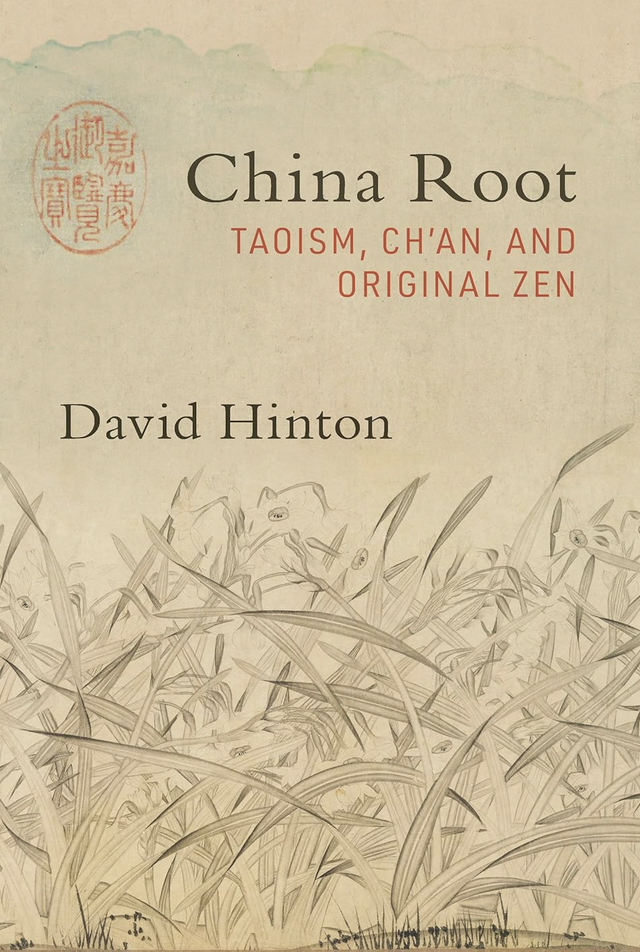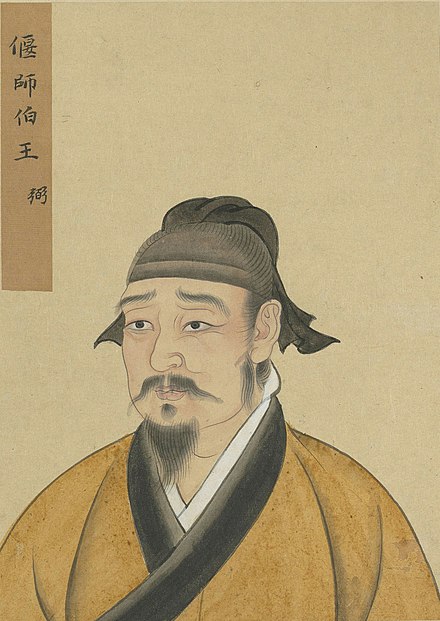While the central thrust of Zen practice is to be immediately present in one’s life, rather than living lost in the isolate realm of thought, Zen’s native Taoist/Ch’an framework adds profound and unexpected dimensions to that presence, opening the possibility of weaving consciousness into landscape, earth, Cosmos (David Hinton).
Early roots in China’s gynocentric Paleolithic culture

In China Root, prominent translator David Hinton describes Ch’an as defined in Bodhidharma’s famous lines as a return to one’s “original nature.” Though these lines were attributed to Bodhidharma, a Buddhist master from South India who traveled to China in the 6th century, Hinton believes that they reflect a Taoist insight with ancient roots in China’s predynastic history, and presents in the book a detailed review of the maturation of this insight within Chinese Taoism going back to Paleolithic times “when humans were still rooted in natural process and yet separate enough to produce a rich artistic and spiritual tradition.” It was a time when “language (existing as thought and speech) and all mental process moved the way everything else moved: appearing, evolving, disappearing. There was no fundamental separation between subjective and objective realms.” This came to an end “when people began settling into villages (permanent enclaves separate from the landscape) and began controlling ‘nature’ in the form of domesticated plants and animals.” This resulted in the emergence of a “detached instrumentalist relationship to the world.” Then, the invention of writing reified “the things of this world as objects of transcendental thought, as ontologically out there and other than us. It replace[d] the immediate experience of things in and of themselves with knowledge and explanation of them.”
In The Way of Ch’an, which Hinton describes as a companion work to China Root, he adds that the hunter-gatherer cultures of the Paleolithic recognized the empirical Cosmos as “female in its fundamental nature, as a magisterial and perpetually generative organism in constant transformation” with spiritual practices celebrating “that generative Cosmos as a Great Mother who continuously gives birth to all creation, and who also takes life and regenerates it in an unending process of life, death, and rebirth.”
Rupture with nature marked by a switch to an androcentric worldview
Hinton explains that with agriculture, and even more so with the emergence of “civilisation,” which coincided with the advent of writing, came the illusion of a human realm separate from “nature” and “this process of rupture entailed a shift from the Paleolithic’s gynocentric worldview to an androcentric worldview. In China, the process was complete by the historical beginnings of Chinese civilization in the Shang Dynasty (1766-1040 BCE), which was indeed fiercely patriarchal. In the Shang, it was believed that all things were created and controlled by a male and all-powerful monotheistic deity very like the sky-god of Judeo-Christian theology, a deity known simply as Lord-Celestial [Shangdi] … Lord-Celestial’s provided [the] rulers with a transcendental source of legitimacy through lineage. And it gave them god-like power, because through prayer and ritual they could influence Lord-Celestial’s shaping of events. All aspects of people’s lives were thus controlled by the emperor: weather, harvest, politics, economics, religion, etc.”
Collapse of the androcentric order and Taoist recovery
The Shang dynasty was eventually overthrown by the Chou dynasty (1040-223 BCE) whereupon “the Chou rulers reinvented Lord-Celestial as an impersonal ‘Heaven’, thus ending the Shang’s claim to legitimacy by lineage. The Chou rulers justified their rule by claiming they had the ‘Mandate of Heaven’, so when their rule was in turn overthrown, the last semblance of theocratic cosmology crumbled, leaving no organizing system to structure society. Philosophers such as Lao Tzu and Confucius (c 5th-6th centuries BCE) struggled to invent a new philosophical framework that could replace the spiritualistic system with a humanistic one based on empirical reality. One aspect of this transformation was the reinvention of Heaven as an entirely empirical phenomena – the generative cosmological force that drives the ongoing transformation of natural process – thereby secularizing the sacred while at the same time investing the secular with sacred dimension: what we today would call a form of pantheism.” In other words, the Christian-like theocracy gave way to a secular humanistic outlook, through a transfer of the sacred to the secular in the form of pantheism.
From theocracy to sacred secularism to a dropping of metaphysical presuppositions
In the West, the collapse of metaphysics is associated with Nietzsche’s statement that “God is dead.” With this brutal statement, not only was God’s absolute transcendence denied, but the belief in a pre-existing order beyond the physical – that is meta-physics – was rejected. There was no transfer of the sacred to the secular, and the things of the world were regarded as objects to be used by humans to meet their egocentric needs and whims. Hinton tells us that in China, the “secularization of the sacred” was soon “superseded by an entirely secular concept: Tao, which was essentially synonymous with ‘heaven’, but without the metaphysical implications.” The concept of Tao was already central in the I Ching loosely dated to the second millennium BCE, and constitutes the central teachings of Lao Tzu’s Tao Te Ching and Chuang-Tzu in the 6th to 4th century BCE. And this was made possible by a return to the earlier gynocentric worldview which saw the Cosmos itself as a generative power (the “Te” in the Tao Te Ching). “Lao Tzu uses the term Tao to describe the empirical Cosmos as a single living tissue that is inexplicably generative in its very nature.“ So, “it represents a return to the earliest levels of proto-Chinese culture: to the Paleolithic, it seems, where the empirical Cosmos was recognized as female in its fundamental nature.” For Hinton the fact that “high Chinese civilization was able to retrieve its origins in a gynocentric primitive is truly remarkable.”
Absence and Presence

In Hinton’s view, though it only arose in 3rd century CE with Wang Pi (226—249 CE)’s School and the Dark-Enigma Learning school, (traditionally referred to as the Profound Learning school) which had already come under the influence of Buddhism, Ch’an as such was primarily the product of the Taoist cultural complex described above. He writes: “Only when it’s seen this way can it really be understood.” This is so because, notwithstanding the efforts of the schools such as the Madhyamaka, the Yogacara and the Tathagatagarbha, as a Buddhist practice Ch’an is made to appear as based on a metaphysical view wherein “emptiness” is the ground of reality, i.e., a “me-ontology” wherein emptiness is a mere substitute for “being” as ground. Since it does not jettison the concept of “ground” or “substratum, ”it stops short of being an “anontology.” Taoism rests on a pure empirical experience of the ten thousand things as they emerge empirically from Absence into Presence. These things “simply are,” and what is referred to as The Way consists in responding appropriately to their presencing. It is not the quest of a Truth in an emptiness beyond the things as they appear to us that would be more “real”. The goal of Taoist practice is “to integrate oneself into the unfolding of Presence (ten thousand things) from the generative source.”
In the West, “Ch’an is presented as if it were Japanese”
Hinton then argues that Zen as presented in the West is “a stream of Buddhism that began in India, passed through China (with significant developments), then through Japan (where it became known as Zen, the Japanese pronunciation for the Ch’an ideogram, and developed further), and then twelve centuries later passed on to America,” and from there to all Western countries, “where the tradition is primarily shaped by its Japanese antecedent.” In his view, “this narrative involves a stunning project of cultural appropriation in which Ch’an is presented as if it were Japanese: the names of Chinese Ch’an masters have been widely rendered in Japanese, as have important terminology including zen, koan, kensho, satori, mu.”
Hinton, however, adds “That story isn’t wrong, but it leaves out just about everything that matters to Ch’an. It would be more accurate to say that when Buddhism arrived in China during the first century of the current era, it was fundamentally reinterpreted and reshaped by Taoist thought, its more abstract metaphysical sensibility becoming grounded in an earthly and empirically based vision. The result of this amalgam, which began to take shape from the 3rd into the 5th centuries CE, is Ch’an. And in this transformation, Buddhism is so transformed by Taoist thought that, aside from a few institutional trappings, it is scarcely recognizable as Buddhism at all.” So, this is not to say that Buddhism played no role in the genesis of Ch’an. “But it may still be more accurate to simply say that the influence of Buddhism pushed native Chinese philosophy to a new level of clarity and intensity, for the originators of Ch’an essentially adopted aspects of Buddhism (texts, ideas, practices) that they found useful in enriching their own Taoist understanding, while reconceiving them fundamentally in Taoist terms. Most important among these imported Buddhist elements was a central focus on the nature of empty-mind meditation known as dhyana … Ch’an found dhyana meditation a useful stage in training, but at more advanced levels reconceived and in the end dismantled it, returning to an enriched version of ancient Taoism’s concept of meditation. And Buddhism functions more generally as a conceptual framework to dismantle – part of the Ch’an adventure of razing all conceptual constructions. This imperative to disassemble ideas was certainly present in the forms of Buddhism that arrived in China, part of why it appealed to China’s artist-intellectuals. But Ch’an deconstruction operates very differently because it was primarily inherited from early Taoism. In the end, Ch’an’s deconstructive project extends a tradition of demolition that was the essence of Taoism from its origins in the Tao Te Ching, and the end result of the dismantling is defined by the earthy Taoist/Ch’an conceptual framework.”
So, as Hinton sees it, Ch’an was less Buddhism than a rebellion against Buddhism. And in the end, it is most accurately described “not as Buddhism reconfigured by Taoism, but as Taoism reconfigured by a Buddhism that was dismantled and discarded after the reconfiguration was complete.” This is how China’s artist-intellectual class saw it: Ch’an as a refinement and extension of Taoism. Indeed, the more Ch’an is seen at the deep levels essential for awakening, the more Taoist it looks; while the more it is seen at shallow or institutional levels, the more Buddhist it looks.”
Hinton concludes the introduction to China Root with the words: “Once reinvested with its Taoist/Ch’an roots, it becomes not just straightforward and accessible, but also dynamic with the fertile energy of earth and Cosmos. And those roots transform generic ‘Zen perplexity’ into an earthy mystery that can easily be inhabited in daily life. For while the central thrust of Zen practice is to be immediately present in one’s life, rather than living lost in the isolate realm of thought, Zen’s native Taoist/Ch’an framework adds profound and unexpected dimensions to that presence, opening the possibility of weaving consciousness into landscape, earth, Cosmos.”
Sources:
David Hinton – China Root – Taoism, Ch’an, and Original Zen
David Hinton – The Way of Ch’an – Essential Texts of the Original Tradition

